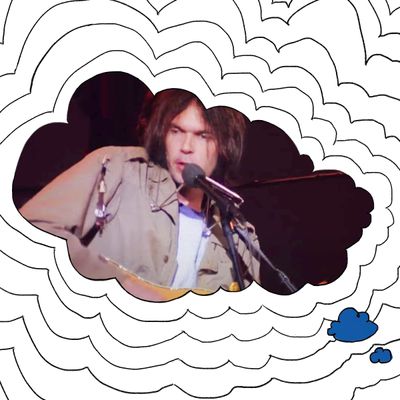
“I Think About This a Lot” is a series dedicated to private memes: images, videos, and other random trivia we are doomed to play forever on loop in our minds.
There’s a corner of rock history reserved for tall tales that get passed down through the years because of how they mythologize a specific artist’s genius or the excesses of an era. The 1970s, in particular, churned out story after exaggerated story of hyperproductive studio sessions and rumored romances between icons. Here was a decade, for example, where Joni Mitchell could write a song that sounds an awful lot like it’s about Sam Shepard without posting a clarifying tweet afterward. I’ve always been an avid collector of such stories, not because they’re necessarily true but because they capture something almost mythical about the era’s freewheeling recklessness, hinting at the artists’ talents but also at what they could get away with behind the scenes. To that end, I’ve spent probably too much time thinking about Neil Young’s alleged cocaine mishap during the filming of The Last Waltz, Martin Scorsese’s documentary on the Band’s farewell concert.
Filmed on Thanksgiving in 1976, The Last Waltz features an all-star lineup of what was becoming rock’s Old Guard, including Van Morrison, Joni Mitchell, and Bob Dylan. As the story goes, Young partook in some activities backstage before joining the Band in performing his song “Helpless,” during which he had a visible cocaine rock hanging out of his nose. The powder — according to the 2002 Young biography, Shakey — proved so unmissable in the footage that Young’s longtime manager demanded that Scorsese have it removed in postproduction. The Mean Streets director pushed back, insisting that the coke-covered nose was “rock and roll,” but relented in the end, and the crew devised a special effect (dubbed “the traveling booger matte”) to hover over Young’s face during the performance. This being 1976, applying the effect supposedly took a lot of time and money, leading Band member Robbie Robertson to quip that it was “the most expensive cocaine [he] ever bought.”
Predictably, the mishap was but one of many during the making of The Last Waltz, which sounds overall like it was a process of herding cats. The coke nose, though, rattles around my brain as a shining example of rock-star carelessness creating a headache for the cleanup crew. Decades before assigning The Irishman’s special-effects team the impossible task of making a septuagenarian Robert De Niro look 40 years old, Scorsese apparently instructed some unfortunate crew members to spend hours hunched over strips of film, painstakingly blotting out what could’ve been resolved with a Kleenex. Making matters worse for those of us fixated on the incident, evidence of that labor is scarce even in the internet era, and any undoctored images that might have existed of the coke nose seem to have disappeared into a black hole. Instead, the legend lives on in rock biographies and remains unconfirmed by Young himself (though he told an interviewer cocaine was “kinda the drug of the decade for me.”)
As someone who gets paid to copyedit other people’s work before it goes out into the world, I naturally empathize more in this scenario with the cleanup crew than I do with Young. The simple act of hitting “publish” on certain pieces that I edit hurls me into a brief bout of anxiety, in which a litany of misspelled names and stylistic errors flashes through my head. As a result, nothing could seem more foreign to me in its brash self-confidence than the concept of stepping out onto a stage in front of seven cameras and thousands of people without so much as a glance in the mirror. And yet I can’t help but find something aspirational in Young’s carelessness in this tale and in his simultaneous self-assurance that he’d be able to deliver the goods anyway.
Looked at from one angle, Young’s self-abandon that night is understandable — he had just wrapped up an exhausting Crazy Horse tour the night before — but it’s also in keeping with how he navigated his career in the ’70s. Throughout the decade, Young followed his muse to whichever uncommercial ends it took him, earning him the reputation of a mercurial artist who’s confident even in his missteps. It seems that nothing — not even the threat of failure or embarrassment or losing his fans’ goodwill — held him back. By contrast, I can’t seem to trick my brain into forgetting the time I mispronounced the word debacle while making an announcement at an assembly in my junior year of high school (or into forgetting the fact that I tried to use the word debacle at an assembly in high school). And while Neil Young, the person, might suffer from similar anxieties in his own life, cocaine-mishap Neil exists in my thoughts on a separate plane, radically unaffected by the neuroticism that plagues the rest of us.
At the end of the day, the great cocaine mishap is but one more entry into the canon of tales designed to mythologize an era of rock music, one that reflects the carefree ethos of the ’70s that I find myself drawn to even as it triggers minor anxiety spirals. As for my comrades in the postproduction crew, I can only hope that the story has given them something to dine out on for the past 40-plus years. At the very least, it provided a talking point ridiculous enough to distract us all from the fact that, in the same scene, Young appears to be wearing a T-shirt emblazoned with a diagram of two people sixty-nine-ing.


